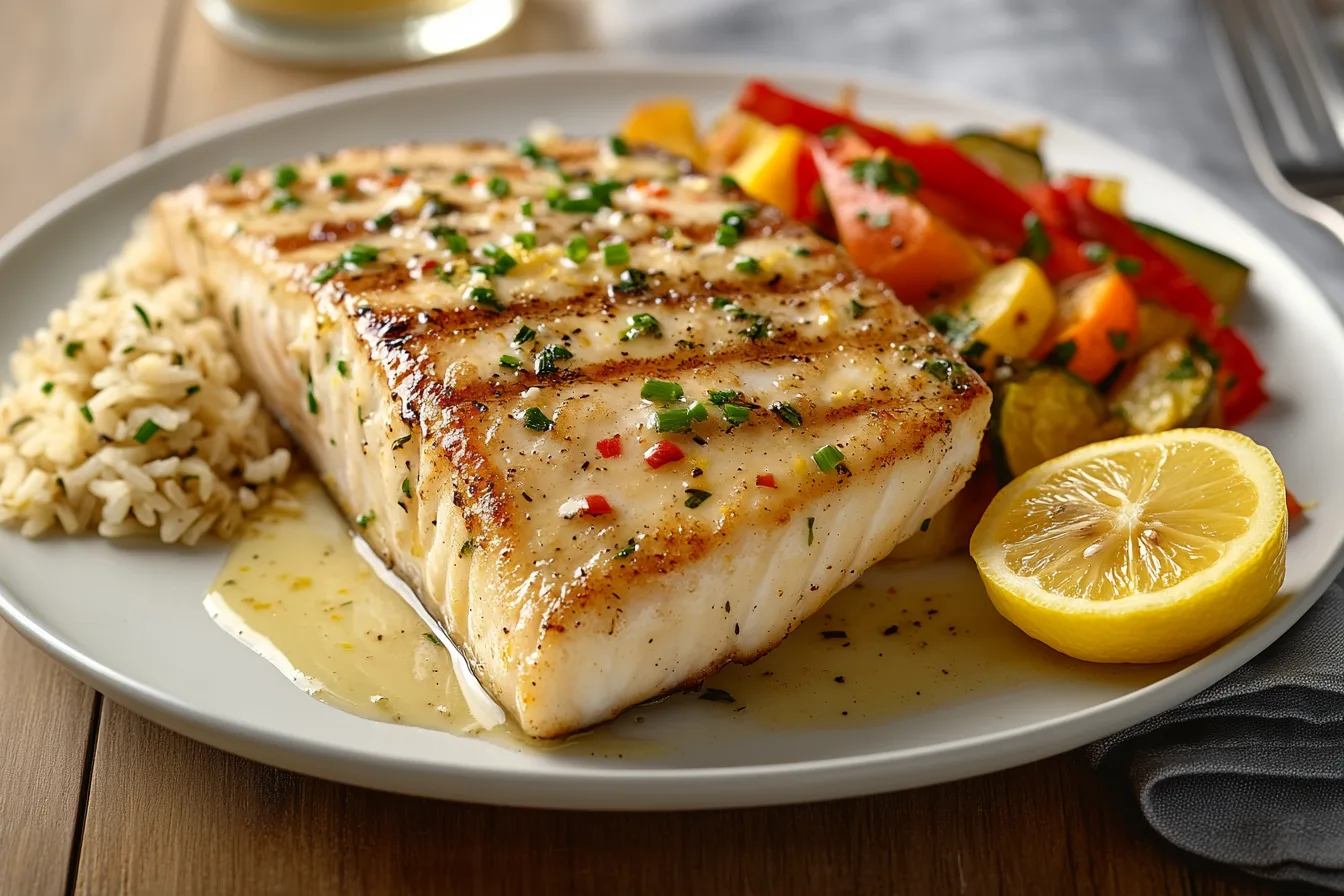This Lemon Garlic Swordfish Is So Good, You’ll Want to Make It Every Week
Introduction
Two pan-seared swordfish fillets in a skillet, drizzled with lemon-garlic butter and garnished with chives and lemon slices. This easy lemon garlic swordfish recipe is about to become your favorite weeknight meal. It’s a homemade swordfish dish that tastes restaurant-quality, yet it comes together in a flash – practically a 5-minute recipe of active cooking time! The swordfish turns out tender and flaky with a luscious lemon-garlic butter sauce that will make you want to mop up every drop. Even if you’re new to cooking fish, don’t worry – this recipe is foolproof and a real crowd-pleaser for family dinners or dinner parties alike. Read on to see why this might be the best swordfish recipe you’ll ever try at home.
Why You’ll Love This Recipe
- Healthy and Nutritious: Swordfish is a lean protein packed with nutrients (a 3-ounce serving has ~20g protein, 0g carbs, plus selenium and vitamin D). This healthy recipe is naturally high in protein, gluten-free, and low in carbs – perfect for a low-carb option or keto-friendly dinner. You get all the benefits of seafood with Omega-3s, without any breading or heavy additives.
- Quick & Easy Dinner: From start to finish, this dish can be on your table in around 15-20 minutes. It’s ideal for busy evenings when you need an easy dinner. The fish sears for just minutes and then roasts for 5–6 minutes – you’ll have a gourmet meal faster than takeout. Talk about quick seafood ideas for a weeknight fish dinner!
- Bursting with Flavor: The combination of zesty lemon, garlic, butter, and fresh chives makes each bite memorable. The lemon-garlic sauce infuses the swordfish with bright, savory flavor without overpowering its mild taste. It’s a balanced flavor profile that even picky eaters will love.
- Minimal Cleanup: Everything is done in basically one pan (an oven-proof skillet), plus a small pan for the sauce. Fewer dishes mean more time to relax and enjoy your evening.
- Impressive yet Simple: This recipe yields a dish that looks and tastes gourmet, so it’s great for entertaining or a date night. However, it’s so straightforward that anyone can pull it off. It’s an easy lemon garlic swordfish recipe you’ll feel confident making, whether it’s a weeknight or a special occasion.
Ingredients You’ll Need
When making the best swordfish at home, using quality ingredients is key. Here’s a rundown of the swordfish ingredients and some ingredient swaps or additions you can consider:
- Swordfish Steaks (2 fillets, 6–7 oz each, ~1 inch thick): Fresh or frozen-and-thawed swordfish will work. Look for steaks that are at least 1-inch thick and a creamy pinkish-white color (a small red bloodline streak is okay, but avoid pieces with dull or brown spots). The thick cut helps keep the fish juicy and prevents it from falling apart. Substitution: If swordfish isn’t available, this recipe works well with other firm fish like halibut, mahi-mahi, or tuna steaks. Just adjust cooking time based on thickness.
- Salted Butter (2 tablespoons, softened): This forms the base of our lemon-garlic finishing sauce, adding richness. Soften the butter to room temperature so it mixes easily with the garlic and herbs. For a dairy-free substitute: swap the butter with 2 tablespoons of a vegan butter spread or extra olive oil. You’ll still get a nice silky sauce, though butter does give the best flavor.
- Fresh Chives (1 tablespoon, chopped): Chives add a mild oniony kick and a pop of color. If you don’t have chives, you can use chopped fresh parsley or green onions as an ingredient swap – the flavor will be slightly different but still herbaceous and fresh. Dried chives can work in a pinch, but fresh is much better here.
- Garlic (2 tablespoons, minced): That’s roughly 4–6 garlic cloves, depending on size. Fresh garlic gives a robust, aromatic flavor to the sauce. If you’re out of fresh garlic, you could use 1 teaspoon of garlic powder as a swap, but the flavor won’t be as vibrant. Minced shallot could also add a mild garlicky-onion flavor as an alternative.
- Fresh Lemon (1 large lemon will yield juice + zest): We’ll use 1 tablespoon of fresh lemon juice and 1 tablespoon of grated lemon peel (zest). The juice brings acidity that brightens the sauce, while the zest packs tons of lemon flavor. Always zest the lemon before cutting it for juicing (it’s much easier). Substitution: Bottled lemon juice can work if that’s all you have, but fresh is best. No fresh lemon for zest? You could add a pinch of lemon pepper seasoning to the sauce for some citrusy kick.
- Olive Oil (2 tablespoons): Used for searing the fish. A good olive oil helps create that golden-brown crust and adds heart-healthy fats. Swap: Any neutral high-heat oil (like avocado oil or canola oil) will do for searing if you prefer a lighter taste, but olive oil pairs nicely with the lemon and garlic.
- Kosher Salt and Freshly Ground Black Pepper: To season the fish. Kosher salt is preferred for its coarse texture and pure flavor – you’ll sprinkle it on the fish right before cooking. Black pepper adds a touch of heat. If you need to watch sodium for a low-sodium version, you can season very lightly or use a salt-free seasoning blend (like Mrs. Dash) along with the pepper. Note: Because this recipe is so simple, proper seasoning is crucial for the best flavor.
Yield: This recipe makes 2 servings (two 6–7 oz swordfish steaks). You can scale it up if needed – just be sure not to overcrowd your pan when searing (work in batches if doubling the recipe).
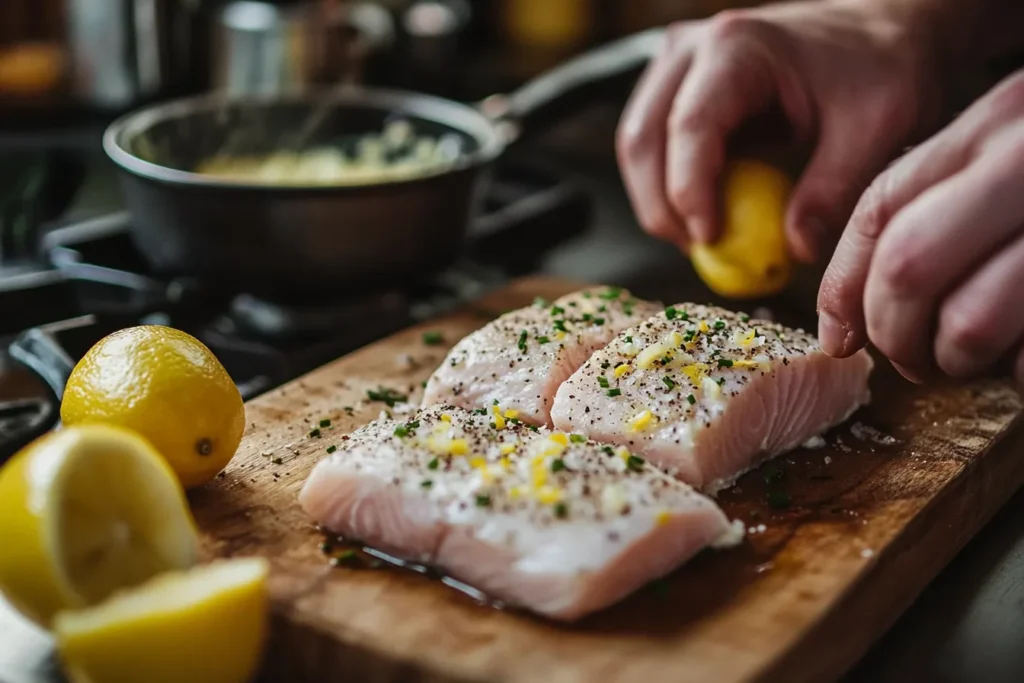
Prep & Total Time
One of the biggest perks of this recipe is how quick it is from start to finish. Here’s the time breakdown for this weeknight fish dinner:
- Prep Time: ~10 minutes (for chopping garlic and chives, zesting the lemon, and mixing the lemon-garlic butter). This also includes time to preheat your oven to 400°F. If you’re an efficient multitasker, you can mix the sauce while the pan is heating.
- Cook Time: ~8–10 minutes total. Searing on the stove takes about 3 minutes on the first side, then another minute after flipping (before transferring to oven), plus ~5–6 minutes roasting in the oven. Meanwhile, melting the lemon-garlic butter sauce at the end adds about 1 minute.
- Total Time: Approximately 18–20 minutes from start to finish. This makes it a quick seafood idea for busy nights. (And remember, much of that time the fish is hands-off in the oven, so it really feels effortless.)
No lengthy marinades or advanced prep required – just a few minutes of effort for a rewarding result. It’s hard to beat a homemade swordfish dinner that delivers gourmet flavor in such little time!
Recommended Kitchen Tools
To make this lemon garlic swordfish successfully, you don’t need any fancy gadgets – just a few kitchen essentials will do. Here are the best tools for swordfish preparation and why they’re useful:
- Large Oven-Proof Skillet (preferably 12-inch, cast iron or stainless steel): This is the workhorse for searing and roasting the swordfish in one pan. An oven-proof skillet (no plastic handles) allows you to move the fish from stovetop to oven seamlessly. A heavy pan like cast iron retains heat well, giving the fish a great sear. If you don’t have an oven-safe pan, you can sear in a regular skillet then transfer the fish to a preheated baking dish to finish in the oven.
- Small Saucepan or Skillet: You’ll use a small pan to melt the lemon-garlic butter sauce at the end. It doesn’t need to be big – even a tiny sauté pan or butter warmer works. (In a pinch, you could even microwave the butter mixture, but stovetop melting gives you more control and aroma.)
- Tongs or Fish Spatula: For flipping the swordfish steaks. Tongs with a good grip are great for thick steaks, but a fish spatula (a wide, thin slotted spatula) also works well to slide under the fillet without tearing it. These tools make it easier to handle the fish gently and safely.
- Microplane Zester or Grater: This will help you finely grate the lemon peel to get that fragrant zest. A microplane makes quick work of zesting citrus and mincing garlic if you want super-fine garlic. If you don’t have one, use the smallest holes on a box grater for the lemon zest.
- Meat Thermometer (Optional but useful): While not strictly required, a quick-read thermometer can be very helpful to ensure your fish is perfectly cooked. Swordfish should reach about 145°F internal temperature for safe consumption. If you pull it at 135–140°F and let it rest a minute, it will carry over to about 145°F. Using a thermometer prevents overcooking, so you get juicy swordfish every time.
- Paper Towels: Often overlooked as a “tool,” but absolutely essential here – you’ll use them to pat the fish dry before cooking (this helps achieve a good sear). Paper towels also come in handy to blot excess oil after cooking, if desired.
Having these tools ready will set you up for success. Now, let’s get cooking!

Step-by-Step Instructions
Follow these how to make swordfish steps, and you’ll have a mouthwatering dinner in no time. We’ve added sensory details and searing tips along the way to guide you. Don’t forget to read the pro tip after each step for extra help in achieving the perfect result.
- Preheat and Prep the Lemon-Garlic Mixture: Preheat your oven to 400°F (200°C) with the rack in the middle position. While the oven heats, combine all the Lemon Garlic Mixture ingredients in a small bowl or directly in a small saucepan: 2 Tbsp softened butter, 1 Tbsp chopped chives, 2 Tbsp minced garlic, 1/8 tsp kosher salt, 1/4 tsp black pepper, 1 Tbsp fresh lemon juice, and 1 Tbsp lemon zest. Stir them together until you have a fragrant, speckled butter paste. Set this aside for now (you’ll melt it later). The mixture will look pale and chunky with bits of green herbs and minced garlic distributed throughout. Pro Tip: Make sure your butter is soft (not melted) so everything combines smoothly. If you forgot to take the butter out in advance, you can microwave it for 5-10 seconds to soften. Also, preheating the oven first thing ensures it’s fully up to temp by the time you finish searing on the stove – a properly hot oven is key for quick roasting.
- Season the Swordfish Steaks: Pat the swordfish fillets very dry on all sides with paper towels. This removes surface moisture that could prevent a good sear. Once dry, sprinkle each fillet with kosher salt and freshly ground black pepper on both sides. Season liberally (about 1/4 to 1/2 teaspoon of salt per side, depending on your salt preference). Press the seasoning in lightly so it adheres. The pinkish-white flesh of the fish should be coated with visible salt and pepper speckles. Pro Tip: Don’t skip drying the fish! Removing moisture is one of the top swordfish cooking tips for achieving a brown crust instead of steaming the fish. Also, it’s best to season right before cooking; salting too early can draw out moisture. If your swordfish has skin on one side, you can choose to trim it off before cooking (as the skin is tough), or cook with the skin side down first to help hold the shape, then remove it before serving.
- Sear the Swordfish on the Stovetop: Heat 2 tablespoons of olive oil in your large oven-proof skillet over medium-high heat. Give the pan a minute or two to get really hot – the oil should shimmer but not smoke. Carefully lay the seasoned swordfish steaks into the pan, presentation-side down first (if one side has a nicer appearance, put that side down). You should hear an immediate sizzle. Sear for about 3 minutes without moving the fish. During this time, the bottom of the swordfish will turn golden brown and release from the pan when it’s ready. You can peek at the edges: they’ll turn opaque about a quarter of the way up. Pro Tip: Resist the urge to fiddle or move the fish too soon. Let it sear undisturbed – this is how you get that beautiful crust. If you try to lift the fish and it’s sticking, it likely needs another minute to sear. Proper searing locks in juices and is the secret to juicy swordfish with a flavorful exterior. (If your fillets are thicker than 1 inch, you might sear for 4 minutes to get a good crust.) You’ll also notice the kitchen filling with a lovely aroma of garlic and lemon already from the seasoned fish.
- Flip and Transfer to Oven to Roast: After the first side is nicely browned, use tongs or a fish spatula to flip the swordfish steaks gently to the other side. They should release easily if properly seared; if not, nudge carefully. Turn off the stovetop heat and immediately transfer the oven-safe pan with the fish into the preheated 400°F oven. Roast the swordfish for about 5 to 6 minutes. The exact time will depend on thickness – a 1-inch thick steak usually needs around 5 minutes to cook through in the oven. You’ll know the fish is done when it’s opaque all the way through and flakes easily with a fork in the center. If using a thermometer, check for ~135–140°F in the thickest part, knowing it will rise a bit upon resting (to reach the safe 145°F). Pro Tip: Be careful not to overcook – swordfish can go from perfect to dry quickly. It’s better to slightly undercook and let it rest for a minute than to leave it too long. For reference, many chefs consider swordfish done at medium (about 130°F) for the most tender texture, but to be safe and flake easily we aim for just about well-done (opaque, ~140°F). If you’re cooking a very thick steak or a double recipe, you might need a minute or two more in the oven. On the flip side, if your pieces are thinner than 1 inch, check them at 3-4 minutes. Remember, the fish will continue to cook a bit from residual heat after you pull it out.
- Finish with the Lemon-Garlic Butter Sauce: About one minute before the fish is due to come out of the oven, place the small saucepan with the prepared lemon-garlic butter mixture on the stovetop over medium-high heat. (If you mixed it in a bowl, transfer it to a small pan first.) Let the mixture heat up and melt, stirring frequently. It will go from a paste to liquid gold, and once it starts bubbling around the edges and the garlic is fragrant, turn off the heat. By now, your swordfish should be cooked through – carefully remove the hot skillet from the oven (use oven mitts!). Immediately pour the hot lemon-garlic butter over the swordfish fillets. You’ll hear a satisfying sizzle as the sauce hits the hot pan and fish. Tilt the pan to gather any pan juices (the olive oil and fish drippings) and spoon those over the top as well. The final touch is a beautiful glossy sauce with bits of green chive and garlic on the fish. Pro Tip: For extra flavor, after pouring the sauce, you can flip the fillets in the pan once to coat both sides in the lemony garlic butter. Also, feel free to garnish with additional fresh chives or even a few extra lemon wedges for presentation. Take a moment to appreciate the aroma – buttery garlic and fresh lemon, yum!
- Serve and Enjoy: Transfer the swordfish steaks to plates. Spoon any remaining sauce from the pan over the top. The fish will be tender and should flake easily but still hold together (swordfish’s firm texture makes for a hearty presentation). Serve immediately while everything is warm. This is the point where you’ll watch it disappear fast – it’s that good! Pro Tip: If you want a restaurant-style presentation, you can slice the swordfish steak in half on a bias and fan it out, or simply top each steak with a thin slice of fresh lemon and a sprinkle of chives. Serving on a warmed plate also helps keep the fish hot longer. Enjoy your masterpiece!
By following these steps, you’ve just made a delectable homemade swordfish dinner. Savor the moment and the compliments from your lucky diners!
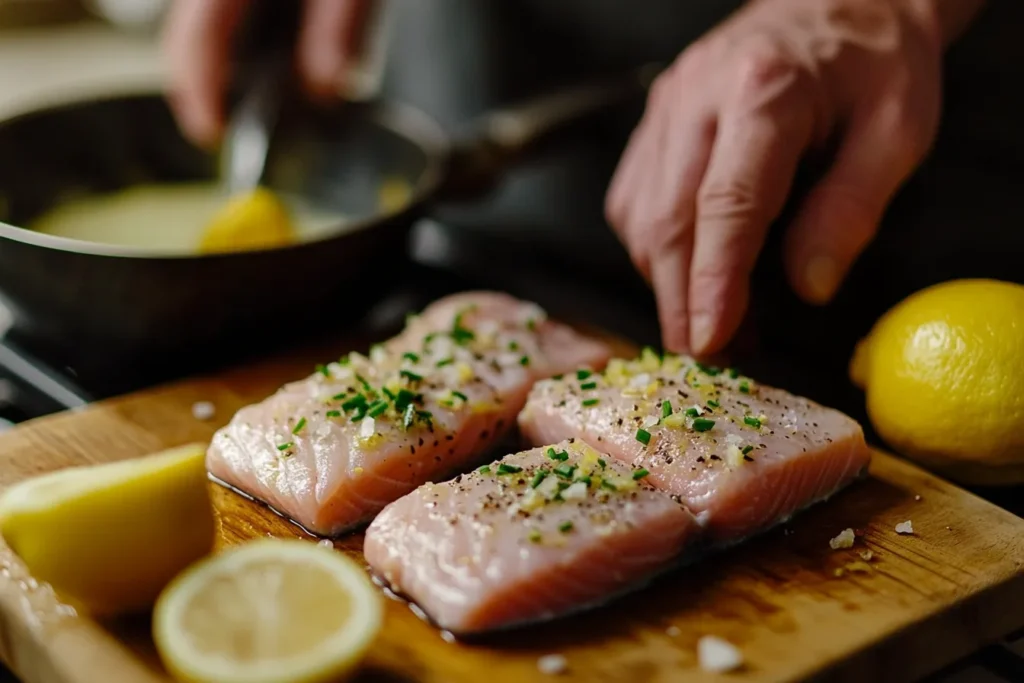
Nutrition Info (Per Serving)
Wondering about the nutritional profile of this lemon garlic swordfish? Here’s an estimate per serving (for one 6-7 oz swordfish fillet with sauce), so you know exactly what you’re getting in this healthy fish dinner:
- Calories: ~500 calories per serving
- Protein: ~40 g
- Fat: ~30 g (of which saturated fat ~8 g)
- Carbohydrates: ~2 g (virtually no carbs; the small amount comes from garlic and lemon)
- Fiber: ~0.5 g
- Sugar: ~0 g
- Cholesterol: ~120 mg
- Sodium: ~450 mg (will vary based on how much salt you use to season)
Most of the calories here come from the heart-healthy fats in olive oil and the butter. Swordfish itself is lean and very high in protein (with zero carbs). In fact, swordfish is an excellent source of selenium and vitamin D, as well as providing Omega-3 fatty acids for heart health. The recipe as written is keto-friendly and low-carb due to the negligible carbohydrates.
If you’d like to lighten it up: You can reduce the butter to 1 tablespoon and use an olive oil spray to sear instead of 2 full tablespoons of oil. That could save around 100 calories and reduce fat, while still keeping the fish moist (though you might sacrifice a bit of richness in the sauce). Using a dairy-free vegan butter would slightly reduce saturated fat and cholesterol as well.
For comparison, a plain 6 oz grilled swordfish (no butter sauce) is about 300 calories, 45g protein, 8g fat. Our recipe adds flavor with the lemon-butter, bringing it to roughly 500 calories. It’s still a moderate, nutrient-dense entree, especially considering a similar portion of steak would be far higher in fat and calories. If you serve it with steamed veggies or a salad, you’ve got a very balanced meal.
(Nutrition data is an estimate and can vary based on specific ingredients used.)
Healthy Variations
This recipe is already pretty wholesome, but if you have dietary needs or preferences, here are some clean eating swordfish variations and tweaks. You can maintain flavor while making the dish fit your lifestyle:
- Dairy-Free Version: To make a dairy-free version of this recipe, replace the butter in the lemon-garlic mixture with extra-virgin olive oil or a plant-based butter substitute. Using olive oil will create more of a sauce vinaigrette (think Italian scampi style) but will still carry the garlic and lemon flavors well. You could also use ghee if you’re lactose-intolerant but can handle clarified butter. Everything else in the recipe is already dairy-free and gluten-free.
- Lower Fat / Calorie: For a lighter touch, reduce the butter to 1 tablespoon or omit it, and use just 1 tablespoon of olive oil for searing (a nonstick pan can allow you to use less oil). The fish will still cook nicely, and you can make a quick sauce by deglazing the pan with a splash of white wine and lemon juice instead of using butter. This creates a light, flavorful pan sauce with very little added fat. It’s a great option for a healthy recipe emphasis.
- Low-Sodium: To make this a low-sodium clean eating swordfish dish, use unsalted butter and limit the added kosher salt. You can boost flavor with salt-free seasonings like fresh herbs (add a sprinkle of rosemary or thyme on the fish) or a squeeze of extra lemon at the end to make up for less salt. Another trick: use garlic powder (which often contains no salt) along with fresh garlic for an extra flavor punch without sodium. Remember, swordfish itself has some natural sodium, so it will still be tasty.
- Herb & Spice Variations: Feel free to add or substitute herbs to change the flavor profile while keeping it healthy. For example, add a pinch of red pepper flakes to the lemon-garlic butter for a spicy kick (great for metabolism and flavor), or swap chives for cilantro and add a dash of cumin for a different vibe. You can also incorporate a bit of clean eating by adding fresh vegetables in the pan – e.g., throw in cherry tomatoes or asparagus pieces to roast alongside the fish, creating an all-in-one meal.
- Grilled Lemon Garlic Swordfish: If you want to avoid extra oil entirely, try grilling the swordfish instead of pan-searing. Marinate the fish in the lemon, garlic, olive oil, salt, and pepper for 15 minutes (no butter needed in the marinade), then grill on medium-high for ~4–5 minutes per side. Finish by brushing with a little melted butter or olive oil mixed with chives and lemon zest. Grilling adds a smoky flavor and you’ll skip the need for an oven – perfect for summer and still very healthy.
With these variations, you can customize the recipe to be even more diet-friendly or use what you have on hand. Whether you need a low-carb option, keto meal, or just a lighter dinner, this swordfish recipe is adaptable.

Serving Ideas
Now that your lemon garlic swordfish is ready, you might be wondering what to serve alongside to make it a complete meal. Here are some tasty pairing suggestions – from starches to veggies – to turn this into a memorable dinner party fish plate. These are the best sides for swordfish in our book:
- Lemon Herb Rice Pilaf: A fluffy rice pilaf with herbs would soak up the extra lemon-garlic sauce beautifully. You can cook rice with a bit of lemon zest or parsley to echo the flavors of the fish. Or consider a hearty whole grain like quinoa or couscous tossed with chopped herbs and a squeeze of lemon. The grains will provide a nice textural contrast to the meaty fish.
- Garlic Roasted Potatoes: Keep the garlic theme going with some crispy roasted baby potatoes or mashed potatoes on the side. The richness of potatoes pairs well with the buttery sauce. For a lighter option, roasted sweet potatoes or cauliflower mash could also complement the swordfish.
- Grilled or Roasted Vegetables: Swordfish loves company from veggies! Try roasted veggies such as asparagus, broccoli, or Brussels sprouts, tossed in a bit of olive oil, salt, and pepper. The caramelized veggies add depth to the plate. Alternatively, grill some zucchini, bell peppers, or eggplant slices while your fish is cooking – the smoky charred veggies alongside the bright lemony fish is a winner.
- Farro or Barley Salad: A room-temperature grain salad (like farro or barley) mixed with cherry tomatoes, cucumber, olives, and feta can be a great side. The Mediterranean vibes of such a salad go hand in hand with lemon and garlic swordfish. Plus, it adds a healthy fiber boost.
- Green Salad with Vinaigrette: For a lighter side, a simple mixed green salad with a tangy vinaigrette provides a refreshing contrast to the buttery fish. You can even incorporate fruit like orange segments or grapefruit into the salad – citrus fruits go well with seafood.
- Steamed Vegetables with Almonds: If you want something quick, steam some green beans or broccoli and sprinkle toasted almonds on top. The crunch of nuts and the clean taste of steamed greens complement the richness of the swordfish.
- Crusty Bread: Last but not least, don’t underestimate a nice piece of crusty bread or dinner rolls. They’re perfect for sopping up any extra lemon-garlic butter on your plate. Your guests will appreciate this touch, especially if it’s a dinner party setting.
For a complete experience, you could even pair this dish with a glass of crisp white wine (like a Sauvignon Blanc or Chardonnay) which goes beautifully with lemony seafood. And if you’re feeling fancy, serve a light dessert afterward, because this meal, while satisfying, won’t leave you overly stuffed. The versatility of swordfish means it works with many sides, so you can’t go wrong – from rice pilaf to roasted veggies, choose your favorites and enjoy a well-rounded dinner.
Mistakes to Avoid
Cooking swordfish is relatively straightforward, but there are a few common pitfalls to watch out for. Here are 5 key swordfish cooking tips to ensure you avoid mistakes and never end up with a rubbery or dry result. If you address these, you’ll easily fix dry swordfish issues and elevate your cooking game:
- Using Low-Quality or Old Fish: Starting with a subpar piece of fish is the first mistake. A poor-quality swordfish steak can be fishy, dry, or have an off texture no matter how well you cook it. Fix: Buy the freshest swordfish you can find. Look for moist, firm flesh with no strong “fishy” odor. If fresh isn’t available, high-quality flash-frozen swordfish is a great alternative (often frozen at peak freshness). Avoid steaks with dark brown blemishes, as those areas have a strong flavor and tougher texture. Treat your fish right from the start and you’re halfway to success.
- Skipping the Drying Step: As mentioned earlier, not patting your fish dry can sabotage your sear. Wet fish going into a hot pan will steam instead of sear, meaning you miss out on that delicious browned crust. Fix: Always thoroughly pat the swordfish dry with paper towels before seasoning and searing. It’s a simple step that makes a big difference in texture. If you have an extra few minutes, you can even let the salted fish sit uncovered in the fridge for 15-30 minutes to air-dry slightly (as long as you plan to cook it right after). This helps draw out excess moisture for an even better sear.
- Under-seasoning the Fish: Swordfish has a mild flavor, which is wonderful, but it needs sufficient seasoning to shine. A common mistake is being too timid with salt and pepper, resulting in a bland outcome. Fix: Season generously! Don’t be afraid to use kosher salt and freshly ground pepper on both sides of the steak. It might look like a lot of salt, but remember you’re seasoning a thick piece of protein. Proper seasoning brings out the natural sweetness of the fish and stands up to the lemon-garlic sauce. (If you’re on a low-sodium diet, you can find other seasoning alternatives as noted above – but do something to add flavor, even if it’s herbs or spices.) Also, season just before cooking to avoid drawing out moisture.
- Pan Not Hot Enough (or Overcrowding): If your pan isn’t hot enough, the swordfish will slowly cook and turn pale gray without browning, and it may stick. Similarly, overcrowding the pan (trying to sear too many pieces at once) will drop the pan’s temperature and cause steaming. Fix: Preheat your skillet over medium-high until the oil is shimmering. The fish should sizzle loudly when it hits the pan. Cook in batches if necessary – it’s better to sear two at a time than cram four steaks in one pan. A properly heated pan = a nice sear. Also, use a pan that’s the right size; too large and any empty surface could burn oil, too small and you crowd the fish.
- Moving or Flipping Too Soon: We get it, you’re eager to check it – but constantly moving the fish will disrupt the sear and can tear the meat. Flipping too early can also cause sticking if the crust hasn’t formed. Fix: Once the swordfish is in the pan, let it cook undisturbed for the suggested time (about 3 minutes, depending on thickness). You can gently test with a spatula; if it doesn’t release easily, give it more time. The fish will naturally release from the pan when the sear is complete. Flip only once. This ensures a nicely browned exterior and keeps the interior moist. It’s one of those swordfish cooking tips that applies to cooking any fish or meat: patience pays off in flavor.
- Overcooking the Swordfish: Perhaps the most common mistake – swordfish is lean and can turn dry and tough if overdone. Overcooking will ruin that lovely texture and juiciness. Fix: Be vigilant with your timing. As a rule, about 5-6 minutes per inch of thickness total cooking time is a ballpark (e.g., a 1-inch steak might need ~3 min sear + 5 min roast). Use visual cues: the flesh turns opaque and flakes easily when done. If you have a thermometer, use it – take the fish off heat at ~140°F in the center (it will rise to 145°F as it rests). Remember you can always cook it a tad more if needed, but you can’t un-cook a dry piece of fish. When in doubt, err on the side of slightly under and let it rest; carryover heat is your friend.
- Not Letting it Rest (Briefly): While not as crucial as with red meat, giving swordfish a minute to rest after cooking can help juices redistribute. Cutting or serving it immediately straight from high heat could cause juices to spill out. Fix: After you remove the fish from the oven and pour the sauce, let the fillets sit in the pan or on a plate for 1-2 minutes before digging in. This short rest also allows the internal temperature to even out (especially if you cooked to the lower end of doneness). Meanwhile, you can be plating sides. Resting will ensure each bite is as juicy as possible.
By keeping these mistakes in mind, you’ll avoid the common pitfalls. In short: start with good fish, keep it dry and seasoned, use high heat, be patient while searing, and don’t overcook it. Follow those guidelines and your lemon garlic swordfish will turn out perfectly tender and flavorful every time!
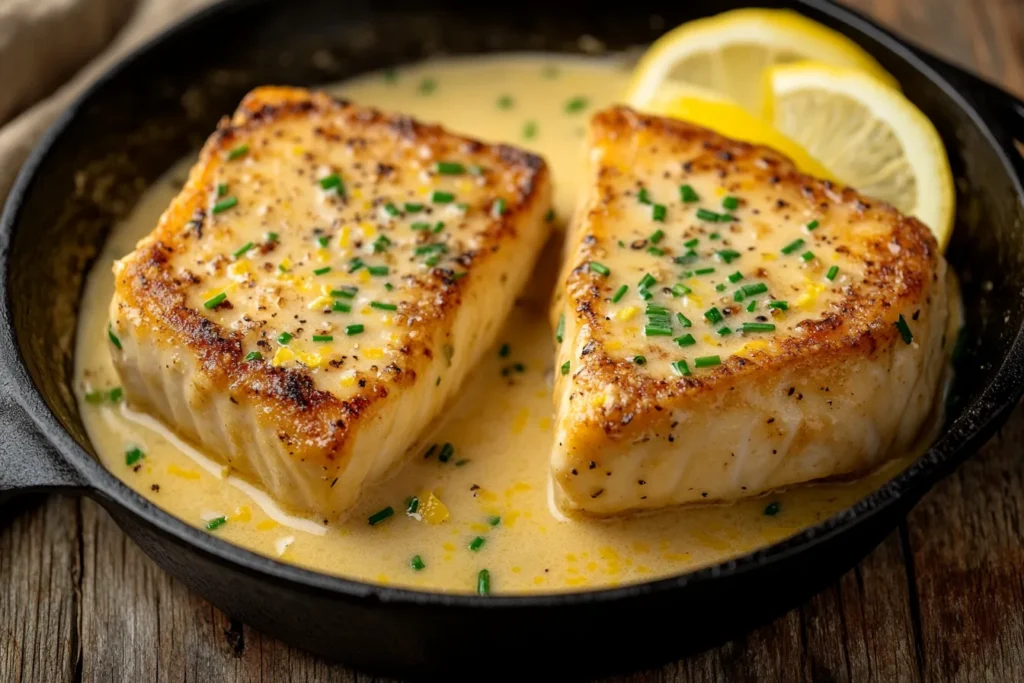
Storage & Make-Ahead Tips
If you have leftovers (a big if, because this is so tasty), or if you want to prep components ahead of time, here are some fish storage tips and make-ahead ideas. Proper storage will keep your swordfish delicious even the next day, and a bit of planning can turn this into a meal prep fish recipe too.
- Refrigerating Leftovers: Allow the cooked swordfish to cool slightly (no more than 30 minutes at room temp for safety). Then place it in an airtight container. You can spoon any remaining lemon-garlic sauce over the top to keep it moist. Store in the refrigerator for up to 3 days. The swordfish will remain safe to eat for up to 3 days, though it’s best enjoyed within 1-2 days for optimal flavor and texture. The butter sauce will solidify in the fridge, but that’s okay – it will melt again upon reheating.
- Freezing Cooked Swordfish: You can freeze cooked swordfish, though be aware the texture might change slightly (it can become a bit drier when reheated). To freeze, wrap each cooked steak tightly in plastic wrap or foil, then place in a zip-top freezer bag, squeezing out as much air as possible. Freeze for up to 1 month for best results. Pro Tip: Freeze with the sauce: adding a spoonful of the butter sauce on top of the fish before wrapping can help preserve moisture when thawed. Also, label the container with the date. (See FAQ below for more on freezing fish safely.)
- Reheating: The key to reheating swordfish is gentle heat. Quick methods can overcook or toughen it. The best way is to reheat in a 275°F oven, covered loosely with foil, for about 10-15 minutes until just warm. You can add a tiny pat of butter or a splash of water/lemon juice on top before heating to help keep it moist. Alternatively, reheat in a skillet over low heat with a lid on – add a drizzle of olive oil or butter and warm each side for a couple minutes. The microwave is least preferred (it can dry out the fish), but if you must, use a lower power setting and heat in short 30-second bursts with a cover on, just until warm.
- Make-Ahead Elements: While swordfish is best cooked right before eating, you can prepare parts of the recipe in advance. For example, you can mix together the lemon-garlic butter mixture a day in advance and keep it refrigerated. This actually deepens the flavors as the garlic and chives infuse the butter. Just bring it to room temp before you plan to cook (so it melts evenly). You can also pre-chop the chives and garlic a day or two ahead – store the minced garlic in a little olive oil to keep it from drying out, and wrap the chopped chives in a damp paper towel in a container.
- Marinating Ahead (Optional): This recipe doesn’t require marinating the fish (since we’re adding flavor with the finishing sauce). However, if you want to infuse more flavor, you could marinate the swordfish briefly. For example, an hour before cooking, marinate the steaks in a mixture of 1 tablespoon olive oil, 1 tablespoon lemon juice, 2 cloves minced garlic, and some salt and pepper. Don’t go too long with acidic marinades on swordfish – 30 minutes to 1 hour is plenty, otherwise the lemon could start to “cook” the fish. Pat it dry before searing if you do marinate. This step is optional because the recipe is flavorful as-is, but it’s an idea for make-ahead flavor boosting.
- Meal Prepping: If you’re doing meal prep for the week, you can cook the swordfish and store portions with sides in meal prep containers. For example, slice the cooked swordfish and divide into containers with some cooked rice and veggies. When reheating (as noted above), do so gently to keep the fish tender. It makes for a gourmet lunch at work or a quick heat-and-eat dinner. Just be mindful of the 3-day fridge guideline for cooked fish.
By handling leftovers properly, you can enjoy this make-ahead seafood dish later without losing quality. Always remember: when in doubt, follow food safety guidelines – keep cold food cold (refrigerate promptly) and reheat thoroughly but gently. With these tips, none of this delicious swordfish will go to waste!
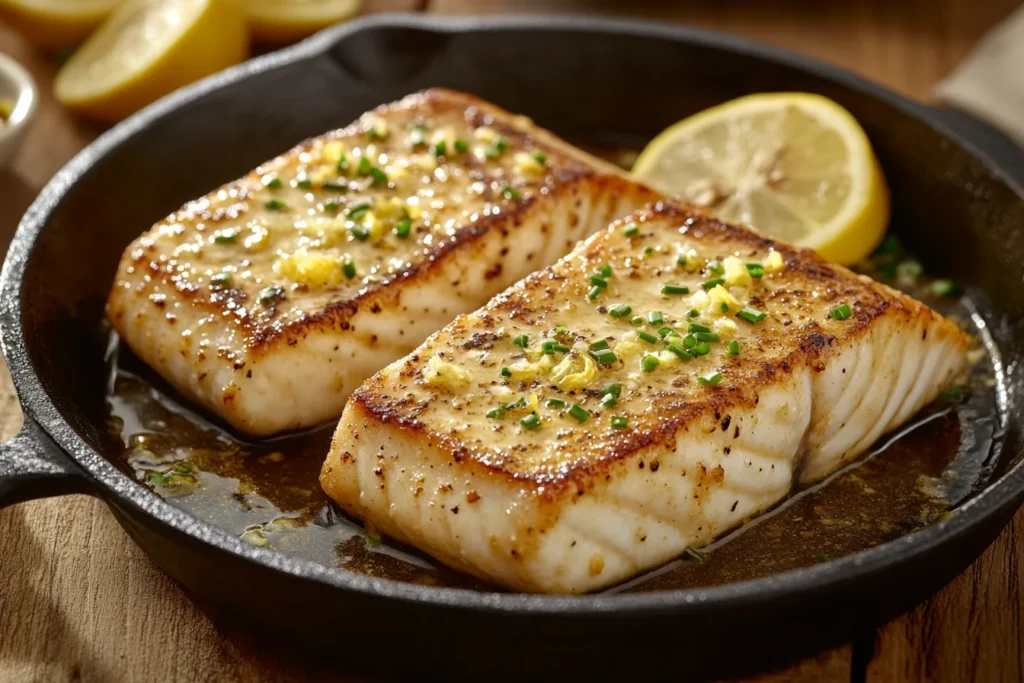
Conclusion
In summary, this lemon garlic swordfish is a crowd-pleasing fish dinner that delivers big on flavor while being incredibly simple to make. You get a beautifully seared, moist swordfish steak bathed in a zesty butter sauce that’s sure to impress anyone at the table. It’s the kind of easy seafood dinner you can whip up on a weeknight, yet it’s elegant enough for special occasions. The best part is that it checks all the boxes: quick, healthy, and downright delicious.
We hope this recipe inspires you to cook more fish at home. Swordfish is often called the “steak of the sea” for its meaty texture, and this preparation really does it justice – tender inside, lightly crisped outside, and bursting with lemon-garlic goodness. Whether you’re a seafood lover or just venturing into cooking fish, this dish is a perfect weeknight meal idea to add to your rotation.
Give it a try and let us know how you liked it! Did you serve it with a side of rice pilaf or a big salad? Did you try any of the healthy variations or have your own twist? We’d love to hear about your experience. Feel free to leave a comment below with your thoughts or questions. Happy cooking, and enjoy your flavorful swordfish dinner!
FAQ
Q: Is this lemon garlic swordfish recipe gluten-free?
A: Yes, absolutely! This recipe is naturally gluten-free. We don’t use any flour or breading. It’s just fresh fish, herbs, citrus, and basic seasonings. That makes it a great option for those who need a gluten-free swordfish dish. Just be sure any sides you serve (like bread or certain grain side dishes) are also gluten-free if needed. The core recipe itself has no gluten-containing ingredients.
Q: How can I make a dairy-free version of this recipe?
A: It’s easy to make this recipe dairy-free. The only dairy here is the butter in the sauce. To create a dairy-free version, substitute the 2 tablespoons of butter with a dairy-free butter alternative or simply use 2 additional tablespoons of olive oil. Using olive oil will still give you a nice garlic-lemon drizzle, though it will be a bit thinner than butter. You could also use ghee if you avoid lactose but tolerate butterfat. All other ingredients (swordfish, olive oil, lemon, garlic, chives) are dairy-free. The result will be just as tasty – a touch less rich, but the lemon and garlic are the stars anyway.
Q: Any tips for giving the swordfish an extra flavor boost?
A: The recipe is flavorful as written, but if you want to elevate it further, here are a few ideas for a flavor boost:
- Marinate briefly: As mentioned in the make-ahead tips, you can marinate the fish for 30 minutes in lemon, garlic, and olive oil before cooking for even deeper infusion.
- Add spices: Try adding a pinch of dried oregano or thyme to the lemon-garlic butter mixture for an herby twist. A dash of paprika or even a little cumin can add warmth and depth too.
- Include capers or olives: Stir in a teaspoon of capers or some chopped green olives into the butter sauce as it melts. They’ll bring a briny pop of flavor that complements the lemon and fish (think of a piccata-style vibe).
- Finish with acid: A final squeeze of fresh lemon on the cooked fish right before serving can brighten it up even more. Some folks even like a drizzle of balsamic glaze for a sweet-tangy finish.
These are totally optional, as the lemon-garlic sauce already does a great job. But feel free to get creative – swordfish is a blank canvas protein that can handle bold flavors.
Q: Can I freeze the swordfish or buy it frozen?
A: Yes, you can use frozen swordfish for this recipe, and you can also freeze the cooked dish. If buying frozen swordfish steaks, thaw them safely (overnight in the fridge is best) and pat them dry really well before cooking. Many high-quality swordfish fillets are flash-frozen at sea, which locks in freshness. In fact, properly frozen fish can be just as good as fresh in terms of taste and nutrition. As for freezing leftovers, as noted above, you can freeze cooked swordfish for up to a month. Just wrap it tightly to prevent freezer burn. When ready to eat, thaw in the refrigerator and reheat gently. Keep in mind that repeatedly freezing and thawing can dry out the fish, so it’s best to freeze only once and consume. If you’re meal prepping, consider freezing the raw swordfish steaks (if they were fresh) and then cooking them fresh when you’re ready, rather than freezing cooked fish, for optimal juiciness.
Q: Can I use leftover swordfish as a salad topping or in other dishes?
A: Definitely! Leftover lemon garlic swordfish is like gold for meal repurposing. You can flake the chilled swordfish into a salad for a protein-packed topping (it’s delicious over a bed of arugula with cherry tomatoes, cucumber, and a light vinaigrette). It’s a nice change-up from the usual chicken or canned tuna on salads. You can also reheat the leftover fish and cut it into chunks to toss with pasta (maybe with a light cream sauce or olive oil, since it’s already seasoned). Another idea: make fish tacos! Warm the swordfish and break it into pieces, then load into corn tortillas with some slaw and extra lemon or lime – a bit unorthodox for swordfish, but super tasty. Essentially, any recipe calling for cooked seafood (like a casserole, a seafood stew, or even a stir-fry) could be an opportunity to use your leftovers. Just remember the fish is already cooked and has a lemon-garlic flavor, so add it at the end of cooking a new dish to avoid overcooking it further. Using it as a salad topping is the simplest and healthiest way to enjoy it a second time, and it really makes for a luxurious lunch.


